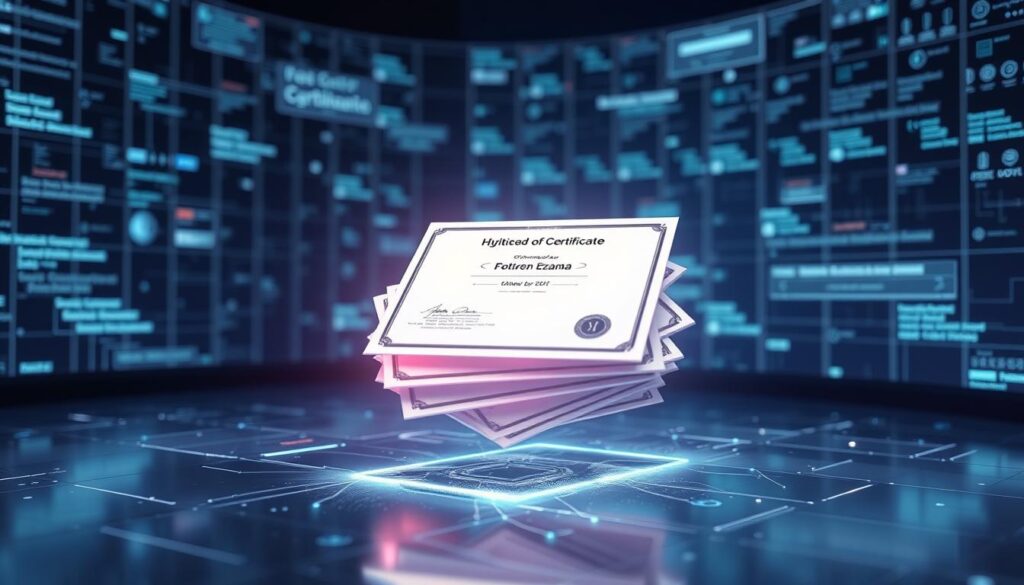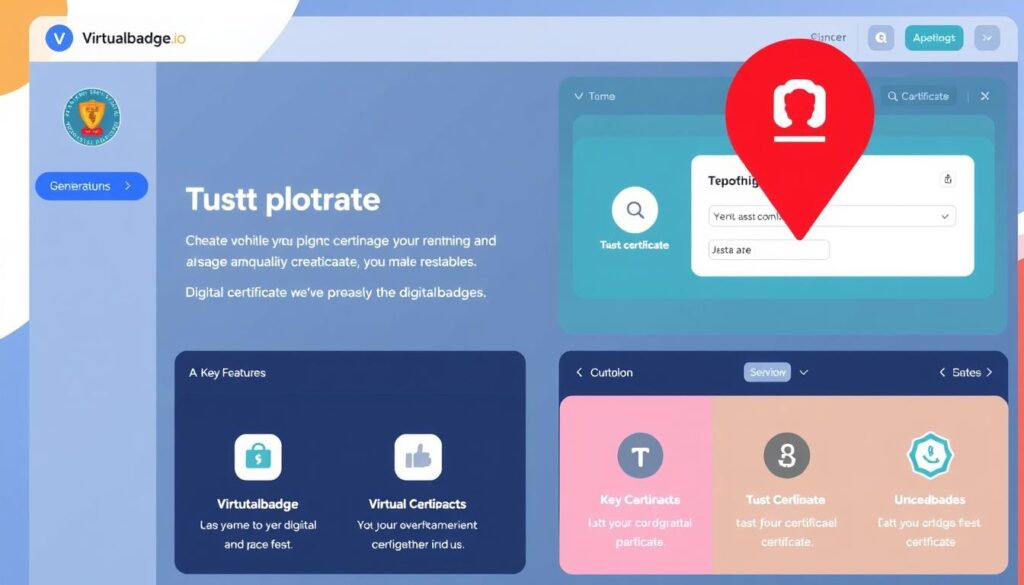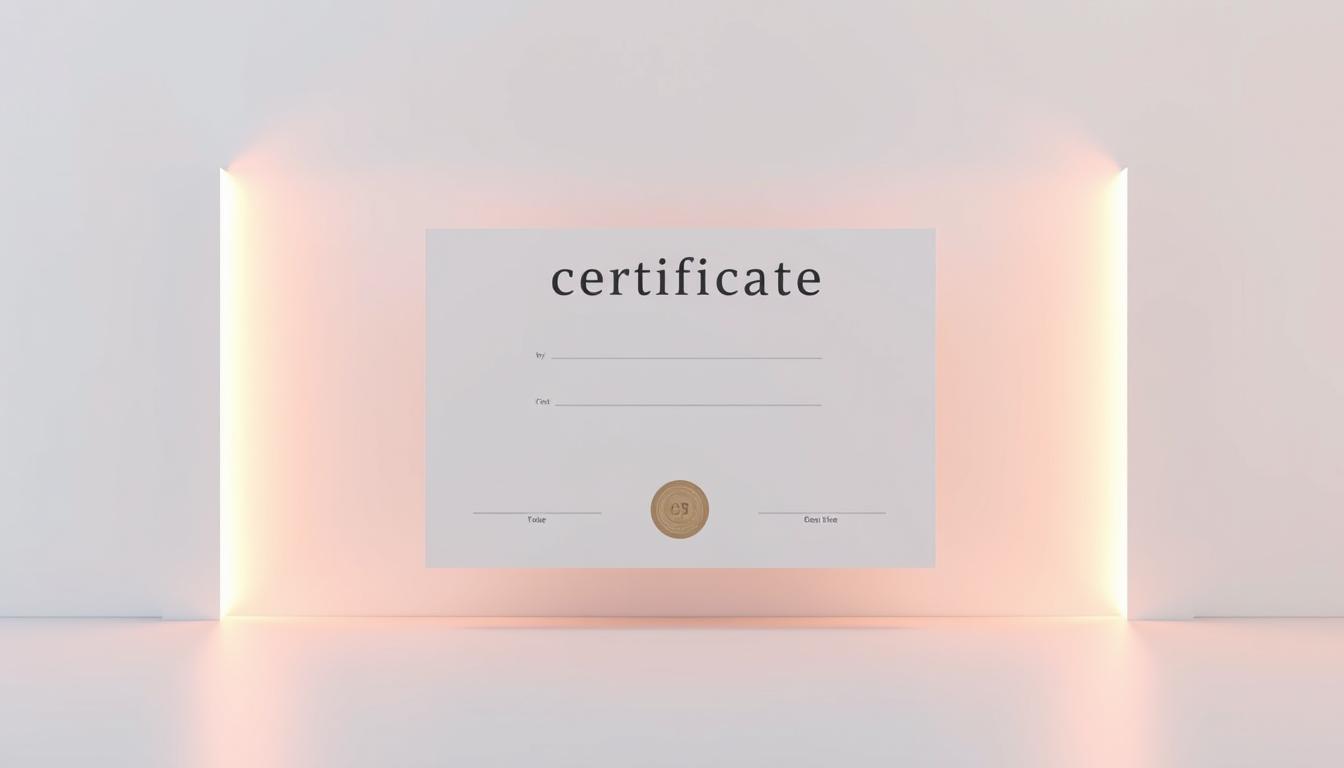In today’s fast-paced, digitally driven world, certificates have become a vital tool for recognizing and verifying achievements. With the rise of online learning, the traditional paper certificate is no longer the most efficient or effective way to award and track accomplishments.
As you navigate the evolving landscape of educational and professional recognition, understanding the role and benefits of digital certificates is crucial. These modern credentials not only enhance security and accessibility but also provide a tangible symbol of accomplishment that can be easily shared and verified online.
By embracing digital certificates, you can streamline the process of issuing and managing credentials, making it easier to recognize achievements and build trust with your audience.
Key Takeaways
- Understand the comprehensive definition and purpose of certificates in today’s educational and professional landscape.
- Learn how digital certificates offer enhanced security and accessibility compared to traditional paper documents.
- Discover the key differences between certificates and digital badges to determine the best recognition option for your needs.
- Explore the process of creating and issuing digital certificates using modern platforms.
- Gain insights into how certificates can build trust, enhance brand visibility, and provide meaningful recognition.
Understanding Certificates: Definition and Purpose
In today’s competitive landscape, certificates have become a crucial tool for individuals to demonstrate their expertise and commitment to their profession. You can leverage these documents to validate your skills and knowledge, making you a more attractive candidate in the job market.
Certificates are typically awarded for completing a course or program of study, and often require you to pass an exam or demonstrate your knowledge through a project or assignment. This process ensures that you possess the necessary skills to excel in your chosen field.
What Defines a Certificate?
A certificate is a document that verifies your completion of a specific training or education program. It serves as tangible proof of your expertise and can be a valuable addition to your professional portfolio.
Common Types of Certificates
There are various types of certificates available, catering to different industries and educational contexts. You can explore academic certificates that validate completion of specific educational programs or courses, professional certificates that demonstrate specialized skills or knowledge, participation certificates that acknowledge attendance at events or workshops, achievement certificates that recognize specific accomplishments, and compliance certificates that verify adherence to industry standards.
- Academic certificates for educational programs
- Professional certificates for specialized skills
- Participation certificates for event attendance
- Achievement certificates for recognizing accomplishments
- Compliance certificates for industry standards
What is a Certificate? Definition and Benefits
Certificates are official documents issued by educational institutions or professional organizations to recognize an individual’s completion of a specific program or course. They serve as a formal acknowledgment of the individual’s achievement and demonstrate a certain level of knowledge or skill.
Comprehensive Definition of Certificates
A certificate is a great way to validate an individual’s completion of a formal program of study. It’s often used by educational institutions and professional organizations to certify that an individual has completed a course or program and has demonstrated a certain level of knowledge or skill. This certification process enhances the individual’s credentials and provides a recognized standard of competence.
Key Components of a Professional Certificate
A professional certificate typically includes several key components that contribute to its credibility and value. These elements work together to establish trust in the certification. Some of the essential components include:
- Proper identification information, such as the recipient’s full name and relevant identifiers.
- The issuing organization’s details, which contribute to the certificate’s credibility.
- Specific achievement descriptions that clearly communicate what was accomplished.
- Dates, including the issue date and, when applicable, expiration or renewal dates.
Additionally, verification methods such as serial numbers, QR codes, or digital signatures ensure the authenticity of the certificate. Visual elements like logos, seals, and signatures enhance the certificate’s professional appearance and legitimacy. For digital certificates, additional components like metadata and blockchain verification may be included to further secure the certification.
The Evolution from Paper to Digital Certificates

The way we recognize achievements has undergone a significant transformation with the advent of digital certificates. This shift is driven by technological advancements that have made it possible to create, issue, and verify credentials in a more secure and efficient manner.
As we explore this evolution, it’s essential to understand the limitations of traditional paper certificates and how digital certificates have addressed these challenges.
Traditional Paper Certificates: Limitations and Challenges
Traditional paper certificates have several limitations, including the potential for forgery, loss, or damage. They are also cumbersome to store and manage, especially for large numbers of recipients. Furthermore, verifying the authenticity of paper certificates can be a time-consuming process.
Digital certificate makers have revolutionized this process by allowing you to create and issue digital certificates to your students, providing a convenient and secure way to recognize their achievements. Digital certificates are harder to forge or tamper with than paper certificates, as they are stored securely online and can be easily validated through a unique URL or QR code.
The Rise of Digital Certificates
The rise of digital certificates has been driven by several factors, including advancements in technology and the need for more secure and efficient credentialing. Digital certificates offer numerous benefits, including enhanced security, improved accessibility, and reduced administrative burdens.
The COVID-19 pandemic has accelerated the adoption of digital certificates across various industries, as organizations seek to adapt to the new normal. The use of blockchain technology and other security measures has further enhanced the credibility of digital certificates, making them a preferred choice for issuing and verifying credentials.
- Digital certificates provide a secure and convenient way to recognize achievements.
- They are stored securely online and can be easily validated.
- The use of digital certificates has streamlined the credentialing process.
Benefits of Digital Certificates

Embracing digital certificates opens up a world of advantages, from enhanced security to improved accessibility. As you transition from traditional paper certificates to digital ones, you’ll experience a significant upgrade in how you issue, manage, and verify credentials.
Enhanced Security and Verification
Digital certificates offer a secure way to issue and verify credentials. With advanced encryption and authentication methods, the risk of fraud is significantly reduced. This ensures that the certificates you issue are genuine and can be trusted by recipients and third-party verifiers alike.
Improved Accessibility and Sharing
One of the key benefits of digital certificates is their ease of access and sharing. Recipients can easily store, share, and display their certificates across various platforms, making it simpler for them to showcase their achievements. This accessibility also facilitates the verification process, as certificates can be quickly validated by employers, educational institutions, or other relevant parties.
Cost and Environmental Benefits
Switching to digital certificates can lead to significant cost savings and a reduced environmental impact. By eliminating the need for paper, ink, and shipping, you can minimize your ecological footprint while also cutting down on operational expenses.
Analytics and Tracking Capabilities
Digital certificates provide valuable data and insights that can inform your credentialing programs. With tracking features, you can monitor when certificates are viewed, downloaded, or shared. This data can help you understand the impact and reach of your certificates, identify trends in recipient behavior, and make informed decisions about future programs.
- Track the performance of your certificate campaigns and assess program growth.
- Gain insights into how recipients interact with their digital certificates.
- Use data to demonstrate ROI and program effectiveness to stakeholders.
Certificates vs. Digital Badges: Understanding the Differences
As you consider how to recognize achievements, it’s essential to understand the nuances between certificates and digital badges. Both are used to validate accomplishments, but they serve different purposes and offer unique benefits.
Level of Detail and Information
Certificates are typically used to recognize completion of a comprehensive course or program, providing a detailed record of achievement. They often include information about the issuing organization, the recipient’s name, and the specific achievement.
In contrast, badges are usually more granular, acknowledging specific skills or achievements within a larger context.
Assessment and Recognition Purposes
The purpose of certificates is often to provide formal recognition of a significant achievement, such as completing a professional course or program. They are commonly used in educational settings to validate a student’s completion of a rigorous program.
Badges, on the other hand, are used to recognize a wide range of achievements, from participation in events to demonstration of specific skills.
When to Use Certificates vs. Badges
The choice between certificates and badges depends on your specific recognition needs. If you’re looking to validate completion of a formal program, a certificate is likely the better choice.
However, if you want to recognize specific skills or achievements, a badge may be more suitable. Some organizations use both in a complementary system, with badges building toward certificate completion.
How to Create and Issue Digital Certificates
Creating and issuing digital certificates can be a streamlined process when you have the right tools and knowledge. With the rise of digital credentials, it’s become increasingly important for organizations to understand how to effectively create, issue, and manage digital certificates.

Designing Effective Certificate Templates
Designing an effective certificate template is the first step in creating digital certificates. Your template should be visually appealing and include all necessary details such as the recipient’s name, the issuing organization’s name, and the date of issuance. Use a clear and concise layout to ensure that the certificate is easy to read and understand.
Setting Up Certificate Campaigns
Once you have your template, the next step is to set up your certificate campaign. This involves deciding on the recipients, the timing of the certificate issuance, and how the certificates will be distributed. Consider using a certificate management platform to streamline this process and ensure that your certificates are issued efficiently.
Distributing Certificates to Recipients
Distributing digital certificates to recipients is a critical step in the process. You can distribute certificates via email or through a dedicated webpage. Make sure to track the distribution to ensure that your certificates are being received and viewed by the intended recipients.
Tracking Certificate Engagement
Tracking certificate engagement is essential to understanding the impact of your digital certificate program. You can track metrics such as view rates, download rates, and social sharing statistics to gauge recipient engagement. This data can help you refine your certificate program and improve its overall effectiveness.
By following these steps and leveraging the right tools, you can create and issue digital certificates that are not only secure and verifiable but also engaging and impactful. With digital certificates, you can enhance the credibility and recognition of your recipients, while also gaining valuable insights into certificate engagement and tracking metrics.
To maximize the reach of your digital certificates, consider sharing them on social media platforms. This can help increase visibility and reinforce the value of your certificate program.
Using Virtualbadge.io for Your Digital Certificate Needs

Discover how Virtualbadge.io can streamline your digital certificate needs with its comprehensive platform. With a user-friendly interface and robust features, Virtualbadge.io makes it easy to create, issue, and manage digital certificates.
Features and Benefits of Virtualbadge.io
Virtualbadge.io offers a range of features that make it an ideal choice for your digital certificate needs. Some of the key benefits include:
- Customizable Templates: Design your certificates using our intuitive template editor or upload your own design.
- Easy Distribution: Send certificates to recipients via email or integrate with your existing LMS or conference tool.
- Tracking and Analytics: Monitor certificate engagement and track recipient interactions.
By leveraging these features, you can enhance the value of your certificates and provide a more engaging experience for recipients.
Getting Started with Virtualbadge.io
To start issuing digital certificates with Virtualbadge.io, follow these simple steps:
- Create an account on the Virtualbadge.io website by providing your name, email address, and password.
- Design your certificate template using our design tools or by uploading your own design.
- Set up your certificate campaign, including configuring email templates and social sharing options.
- Upload your recipient list and send your certificates.
By following these steps, you can quickly get started with Virtualbadge.io and begin issuing digital certificates. Take advantage of our free trial to explore the platform’s capabilities and see how it can benefit your organization.
Leveraging Certificates for Brand Authority and Recognition
By leveraging certificates, you can create a ripple effect that enhances your brand’s reputation and recognition. When you issue certificates to your clients or partners, they are likely to share their achievements on social media, thereby increasing your brand’s visibility.
Building Trust through Certificates
Certificates can significantly contribute to building trust with your audience. When recipients share their certificates, it not only showcases their achievements but also reflects positively on your brand. This can lead to increased credibility and a stronger reputation in your industry.
Boosting Brand Visibility on Social Media
Sharing certificates on social media platforms can have a profound impact on your brand’s visibility. Here are some key strategies to maximize this effect:
- Design certificates that are visually appealing and optimized for social media sharing.
- Incorporate strategic elements like hashtags, mentions, and calls-to-action to expand your reach.
- Use analytics tools to track and measure the social media impact of your certificates.
By implementing these strategies, you can turn certificate recipients into brand ambassadors, further amplifying your brand message onsocial media.
Conclusion
By understanding certificates and their evolution, you’re now equipped to leverage them for your organization’s benefit. You’ve gained a comprehensive understanding of the significant benefits digital certificates offer in today’s digital landscape.
The key takeaways include the enhanced security, accessibility, and engagement tracking provided by modern digital credentials. You’ve also learned how to create, issue, and leverage digital certificates for maximum impact, and how platforms like Virtualbadge.io can streamline this process.
Now that you have the knowledge to implement an effective certificate strategy, we encourage you to start issuing digital certificates and experience the benefits firsthand. By doing so, you’ll be positioning your organization at the forefront of modern credentialing practices.
FAQ
How do digital certificates differ from traditional paper certificates?
Digital certificates are electronic versions of traditional paper certificates, offering enhanced security, verification, and sharing capabilities. They eliminate the need for physical storage and can be easily distributed via email or social media.
Can I customize the design of my digital certificates?
Yes, you can design effective certificate templates that reflect your brand identity. This includes adding your logo, selecting fonts and colors, and customizing the layout to suit your needs.
How do I issue digital certificates to recipients?
You can set up certificate campaigns and distribute digital certificates to recipients via email or social media. This process is streamlined with platforms like Virtualbadge.io, which allows you to track engagement and verify the authenticity of issued certificates.
What are the benefits of using digital certificates over digital badges?
Digital certificates provide a more detailed and formal recognition of achievements, skills, or completions. They are ideal for professional certifications, training programs, and educational achievements, whereas digital badges are often used for smaller accomplishments or milestones.
Can I track the engagement of my digital certificates?
Yes, with digital certificate platforms, you can track how recipients interact with their certificates, including views, shares, and other engagement metrics. This provides valuable insights into the effectiveness of your certification programs.
Are digital certificates secure?
Digital certificates can be made highly secure through the use of verification mechanisms and secure issuance platforms. This ensures that the certificates cannot be tampered with or forged, maintaining their authenticity and value.
